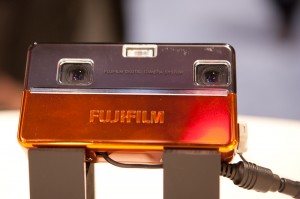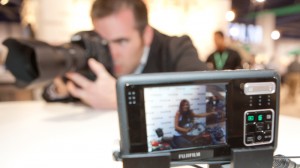 With two lenses, two processors, and a 3D LCD display, this camera takes 3D still and video images. It can also use the two lenses independently, one still one video, or one wide angle one telephoto, for traditional 2D imaging.
With two lenses, two processors, and a 3D LCD display, this camera takes 3D still and video images. It can also use the two lenses independently, one still one video, or one wide angle one telephoto, for traditional 2D imaging.
Unfortunately, like showing HD on regular TV, it’s hard to show the 3D effect here.
The 3D effect appeared as double images unless my eyes were in the right position relative to the screen. Then as I moved my head it was amazing to see the image leap out of the camera while taking a picture. The in-camera menus are in 3D too, which takes some getting used to.
The issue with trying to display the 3D effect of the LCD screen here (I gave up trying) is also mirrored in displaying the 3D images after they’re taken.
This camera is going to need a complete 3D infrastructure to support it. New screens to display the images, new printing machines to make 3D prints to send to your friends, something that is going to take time to put in place.
The prints use lenticular technology, where the image is printed in thin left-eye/right-eye strips which are interlaced across the paper and then a plastic lens overlay is applied which is precisely registered with the images (the hard part) resulting in each eye seeing only one image.
This is something that isn’t possible today in 1-hour labs in the high street shops, making the sharing of these images less immediate than traditional prints. Think of sending off slides for processing and mounting and receiving them a few days later vis the post. I think it’ll start out like that.
Of course we don’t all have 3D monitors either, though the ones on display on the stand looked spectacular they are special purpose for demonstrating this concept camera. So emailing these 3D images or sharing them on websites is going to present more technical problems to be overcome.
It is a glimpse into a possible future, with 3D video and still images one day perhaps as common as our printing and photo-sharing websites are today.
Related Content:
More 2009 PMA Tradeshow News




I have had one of these since November and love it. Originally you could only see the 3D using the lenticular display on the back, but now sites like Stat 3D (http://www.start3d.com) are springing up and enable you to upload the .mpo files that the camera creates and see the 3D effect on your home PC without glasses. You can see some of the photos I have taken with this camera here: http://www.start3d.com/2382528625/
I recommend the camera highly to anyone who wants to get into 3D photography. The camera is far from perfect, but as the first affordable, consumer 3D digital camera, Fuji has made a great step forward and I can’t thank them enough.